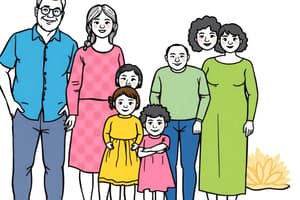Podcast
Questions and Answers
Define the term family and describe two different types of families.
Define the term family and describe two different types of families.
Any group of individuals can be a family. Generally, a family consists of an adult or adults that care for children. Different types of families include single parents, two-parent, extended, adoptive, foster, and blended.
Explain who can be a victim of abuse and how to prevent it.
Explain who can be a victim of abuse and how to prevent it.
Anyone can be a victim of abuse. The best way to resist abuse is to remember the three Rs: recognize, resist, report. It's important to stay away from the abuser and report it to local authorities or authorized school personnel.
How do families develop strong foundations?
How do families develop strong foundations?
Families develop strong foundations by respecting one another, being committed to one another, loving one another, and communicating.
What are three ways family members positively cope with change?
What are three ways family members positively cope with change?
The honeymoon phase in abuse is __________.
The honeymoon phase in abuse is __________.
Giving space and respecting privacy are two ways to build a healthy family relationship.
Giving space and respecting privacy are two ways to build a healthy family relationship.
Men always do the abusing in a relationship.
Men always do the abusing in a relationship.
Describe the differences between the honeymoon phase, tension phase, and violence phase of domestic abuse.
Describe the differences between the honeymoon phase, tension phase, and violence phase of domestic abuse.
Depriving children of food and water is considered neglect.
Depriving children of food and water is considered neglect.
Victims can report abuse by __________.
Victims can report abuse by __________.
All of the following are attributes of building healthy family relationships EXCEPT:
All of the following are attributes of building healthy family relationships EXCEPT:
The lack of proper communication between caregivers and doctors helps to reduce family stress.
The lack of proper communication between caregivers and doctors helps to reduce family stress.
Which statement is most accurate about abuse?
Which statement is most accurate about abuse?
Activities that can help reduce the stress level in a family include __________.
Activities that can help reduce the stress level in a family include __________.
Individuals benefit from __________ about their problems.
Individuals benefit from __________ about their problems.
Helping others with their problems shows your family that you care.
Helping others with their problems shows your family that you care.
Which of the following is NOT an aspect of a family with a strong foundation?
Which of the following is NOT an aspect of a family with a strong foundation?
Children learn to resolve conflicts from surrounding adults.
Children learn to resolve conflicts from surrounding adults.
An extended family consists of aunts and uncles, grandparents, parents, and children.
An extended family consists of aunts and uncles, grandparents, parents, and children.
If you are resilient, then you have the ability to __________.
If you are resilient, then you have the ability to __________.
Flashcards are hidden until you start studying
Study Notes
Family Definition and Types
- A family is any group of individuals, typically consisting of adults caring for children.
- Various types of families include single-parent, two-parent, extended, adoptive, foster, and blended families.
Abuse Victims and Prevention
- Anyone can be a victim of abuse.
- To prevent abuse, follow the three Rs: recognize, resist, and report.
- Recognizing signs of abuse is crucial, and distancing oneself from the abuser is vital.
- Reporting to local authorities or school personnel is a key step toward stopping abuse.
Foundations of Strong Families
- Strong family foundations are built on mutual respect, commitment, love, and effective communication.
Coping with Change
- Discussing issues helps family members cope with change.
- Assisting others fosters a supportive environment and shows caring.
- Building resilience is important to effectively bounce back from life's challenges.
Domestic Abuse Phases
- The honeymoon phase involves the abuser apologizing and making promises; it may include gifts as excuses for behavior.
- The tension phase sees emotions high, leading to conflict buildup.
- The violence phase is characterized by physical or severe verbal abuse.
Neglect and Child Welfare
- Withholding food and water from children constitutes neglect.
Reporting Abuse
- Victims can report abuse through multiple channels, including calling 9-1-1, notifying a teacher, or speaking with trained school personnel.
Healthy Family Relationships
- Key attributes of healthy family relationships include involvement, love, trust, and respect for differences.
- Conversely, holding in anger and failing to express feelings detracts from relationship health.
Misconceptions about Abuse
- It is a common misconception that abuse is the victim's fault; it is never the victim's fault.
- Physical abuse does not only affect the victim; it can have broader psychological impacts on all family members.
Stress Reduction Activities
- Activities like exercising, reading, and going for walks can significantly reduce family stress.
Communication and Problem Solving
- Open communication is essential; individuals benefit from talking about problems rather than keeping silent or resorting to yelling.
- Helping others demonstrates care and support within the family.
Strong Family Characteristics
- Families with a strong foundation exhibit mutual respect, commitment, and effective communication; similar interests are not a necessary aspect.
Learning Conflict Resolution
- Children observe and learn conflict resolution from adults in their environment.
Extended Family Structure
- An extended family includes a wider network, comprising aunts, uncles, grandparents, parents, and children.
Resilience
- Resilience is the ability to bounce back from difficult experiences and is essential for coping with life's changes.
Studying That Suits You
Use AI to generate personalized quizzes and flashcards to suit your learning preferences.




